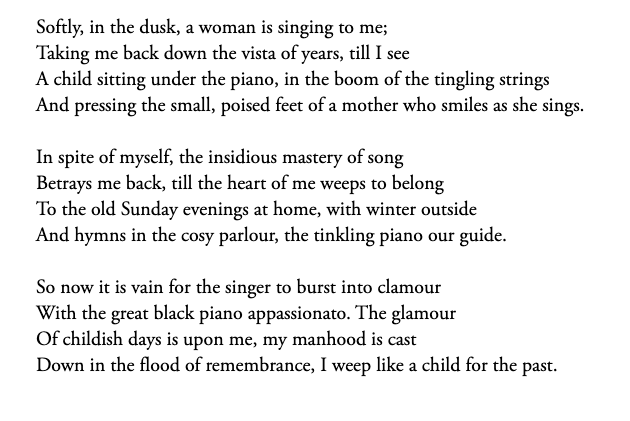A detailed analysis of form, structure and language in DH Lawrence?s poem ?Piano? (1918) ; part of the Edexcel IGCSE Poetry Anthology, and other English Literature exam boards for GCSE and A Level ? AQA, CIE, Eduqas, OCR, WJEC, CCEA and more!
Thanks for reading! If you find this document useful, you can take the full poetry course here:
Edexcel IGCSE Poetry: https://scrbbly.teachable.com/p/edexcel-igcse-poetry
 Photo by James Zwadlo on Unsplash
Photo by James Zwadlo on Unsplash
?my manhood is cast / Down in the flood of remembrance, I weep like a child for the past?
DH Lawrence?s ?Piano? is a poem that beautifully captures a sense of nostalgia, a longing for the past. Below you?ll find the poem and a set of detailed annotations that cover its key concepts and techniques ? use these points in your essays and exams, but also push the analysis further and start to consider your own, personal interpretations of meaning in order to achieve the very top grades!
Piano (1918)

STORY/SUMMARY
Stanza 1: A woman is singing to the speaker, he is playing the piano? ? the setting is ?dusk?, a dark space between day and night. The music and singing take him back in memory to a point where he sees a child sitting under the piano, pressing the feet of his mother who is singing and smiling. We assume he is the child and that this is a childhood memory.
Stanza 2: The music makes him feel strongly nostalgic, he wants to go back to the time when he spent Sunday evenings in winter with his family, listening to them singing hymns in the parlour room with the piano?s music guiding them.
Stanza 3: He seems irritated by the current singer and piano because they are a reminder of his past without being as good as his memories, it is as if he feels that both the piano and singer are singing vainly to amuse or impress themselves, rather than for a communal or spiritual reason, as in his memories. He feels stripped of the pressure and expectations of being an adult, and instead feels young and vulnerable like a child as he strongly misses his past.
STRUCTURE/FORM
non linear chronology ? jumps around between childhood and present via memory, creates an authentic sense of nostalgia
Line length ? lines get longer as the stanza goes on-shows that the speaker is going deeper into his memories, creates slow pace because lines are building up, helps the reader to catch the feeling of memory
Semicolon (caesura) in first line indicates time shift-being taken back to his childhood by the woman singing-like a jolt, disrupting the smooth rhythm of the poem
Many commas which disrupt the flow/rhythm of lines, forcing the reader to take short breaths often- indicates breathlessness and waves of memory, each individual image is coming to him, suggests fragmentation of memory-visual description, energistic
each line is end stopped-each stanza is distinct and separate as they are each their own sentence
Uses quatrains (four-line stanzas)>> the regular structure evokes the shape of a hymn and has a musical verse quality to it, evoking the feeling of lullabies and childhood songs
Rhyme scheme ? AABB (rhyming couplets) ? creates a regular sound pattern, perhaps a soothing and comforting repetition of sound, again evoking a lullaby. Couplets are generally associated with love poetry, so it?s
Internal rhyme-evokes musical quality and places emphasis on those words: ?singer? clamour? ?piano?appassionato? (appassionato= passionately)
LANGUAGE
Emotive language. E.g ?the heart weeps to belong?, ?Down the flood of remembrance?
Continuous verbs ?woman is singing? ?child is sitting? ?pressing? ? constant movement, the memory and present moment seem to fluidly blend with one another, we have a sense of the action unfolding in front of us, we observe the actions in a filmic sense, as if a play is occuring
Semantic field of nostalgia- ?Old Sunday evenings?winter outside?cosy parlour?tinkling piano?- words that seem to be part of a memory help build up an image of comfort and longing/regret in the reader?s head. E.g ?Old?, ?cosy? and ?tinkling? are adjectives which help create an atmosphere of sadness and a bittersweet tone
Sibilance ?a mother who smiles as she sings? ? the repetition of the ?s? sound is soothing, and also helps to create an emphasis on the image of the mother, who is contrasted directly with the ?woman? who is singing at present in the bar ? one a comforting and protective figure, the other cold and self centred or ?vain?.
Static image of the ?singer? and ?the great black piano? representing the present moment, contrasted with a progression of images in the past ?a child sitting under the piano? / ?boom of tinkling strings? / ?pressing the small, poised feet?/ ?winter outside? / ?hymns in the cosy parlour?
CONTEXT
Modernism= artists in the early 1900s, obsessed with being modern, not old fashioned, etc. End of victorian era- Modernists saw Victorians as boring and old fashioned, not embracing the new age.
DH Lawrence was part of ?The Bloomsbury Group?, a talented group of modernist writers whose common themes were psychology, emotion, memory and time.
Lawrence is famous for his sensitive exploration of feelings and emotion, both in his poetry and stories. ?Piano? not only explores the positive aspects of nostalgia, but the sadder and more difficult emotions that comparing the past with the present can bring.
The first version of ?Piano? appeared in a college notebook of Lawrence?s around 1908, approx. two years before his mother?s death. It was edited and revised a lot before being published in 1918.
THEMES
Psychology
Memory
Nostalgia
Pain and Longing
Time
Innocence
Childhood/Adulthood
Thanks for reading! If you find this document useful, you can take the full poetry course here:
Edexcel IGCSE Poetry: https://scrbbly.teachable.com/p/edexcel-igcse-poetry


